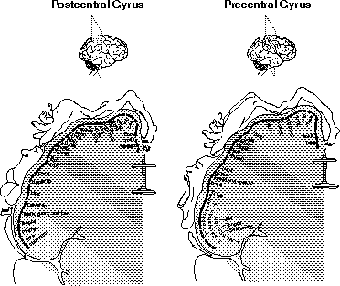Anatomy and Physiology: Sensory and Motor Control
Sensory and Motor Control
Our brain is wired to not only monitor the sensation of the body, but to control the movement as well. Around the middle of the cerebral cortex is a large sulcus called, well, the central sulcus. This marks the division between the frontal and parietal lobes. Given the central location of the sulcus, the gyri are given extremely mundane names: the precentral gyrus (of the frontal lobe), and the postcentral gyrus (of the parietal lobe). Just under each gyrus is gray matter involved in processing the sensory input, as well as motor responses.
To get a true appreciation of this, you must look at the picture of the sensory and motor homunculi (homunculus = little man). As you can see from Figure 20.6, certain regions of the body take up much larger regions of the brain to control. If you were to build a body with these proportions, well, let's just say that I wouldn't want to meet a person like that in a dark alley!
Let's look at each homunculus in a bit more detail. The sensory homunculus is located in the postcentral gyrus of the parietal lobe. Most of the sensory nerves, as a matter of fact, end up in the postcentral gyrus. Take a look at the size of the lips. With so much sensation located there, is it any wonder that we humans love to kiss? We see something similar in infants, who are forever exploring their world by stuffing objects in their mouths. Holding hands is also a big one, for the hands take up an enormous part of the sensory homunculus. On the other hand, you may be surprised how little of the brain involves sensation in the genitals! This makes the old expression that “men think with their penises” seem even more out of proportion!
Flex Your Muscles
One thing that is important to remember here is that the division between the lobes has more to do with the location of the cranial bones than any clear physical division within the brain. Functions of the lobes that occur at the edge of a lobe often involve portions of both lobes along the border (in a form of neural NAFTA).
The motor homunculus of the frontal lobe has some equally cool things. Notice the area that controls the movement of the face. Humans have an enormous amount of flexibility in our facial muscles. With a little practice, you can even make a living at it (think Jim Carrey). Think of how different it is reading an e-mail from someone versus seeing them say it in person. Beyond inflection of the voice, which people can mask, an enormous amount comes across in facial expressions. As such, it makes perfect sense that we also need a large part of the brain to interpret those facial expressions.

Figure 20.6These rather strange little figures illustrate the proportion of the cerebral cortex that is taken up by sensory and motor processing for the various parts of the body.
In terms of art, think about all of the art forms that involve the hands (drawing, painting, sculpting, playing music, and so on) and you can see that they have the brain power to back it up. On the other hand, dancers get kind of screwed in terms of brain area associated with body movement. It makes Gene Kelly's achievements even more amazing!
Limbic System: Seat of Emotion
The limbic system is an amazing thing, for it surrounds the thalamus and the hypothalamus, making it a relatively primitive part of the brain, and yet it controls no less than our emotions. Think about that for a minute. It seems that our emotions evolved long ago, for these structures have been in our ancestors for a long time. Remember how the gray matter is concentrated along the gyri and sulci of the cerebral hemisphere? Well, the region around the thalamus, on top of the brainstem, has a number of areas filled with a gray matter. Together they make up the limbic system (see Figure 20.7).
There are three basic functions of the limbic system: (1) emotional states and drives, (2) helping with memory storage and retrieval, and (3) linking the unconscious work of the brainstem with the conscious control of the cerebral cortex; the limbic system seems to be associated with pleasure and pain. A frontal section of the brain shows numerous areas of white matter carrying nerve impulses between the areas of the limbic system and the cerebral cortex. This accounts for many interesting things, such as the way a smell can trigger a long buried memory, or how we put such emotional contexts to meals; both these situations involve the more primitive senses and memory or emotion. To learn more about certain specific functions by region refer to the following table.
| Regions of the Limbic System and Their Functions | |
|---|---|
| Region | Function |
| Amygdaloid body | Connects limbic system, senses, and the cerebral cortex, anger |
| Fornix | Connects hippocampus to the hypothalamus |
| Hippocampus | Learning (storage of and access to long-term memory) |
| Mammillary body | Processes smell and controls chewing and swallowing reflexes |
| Stria terminalis | Involved in sexual behavior |

Figure 20.7The various regions of the limbic system, which is involved in emotions and memory. (LifeART©1989-2001, Lippincott Williams & Wilkins)

Excerpted from The Complete Idiot's Guide to Anatomy and Physiology © 2004 by Michael J. Vieira Lazaroff. All rights reserved including the right of reproduction in whole or in part in any form. Used by arrangement with Alpha Books, a member of Penguin Group (USA) Inc.
To order this book direct from the publisher, visit the Penguin USA website or call 1-800-253-6476. You can also purchase this book at Amazon.com and Barnes & Noble.
